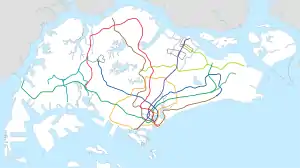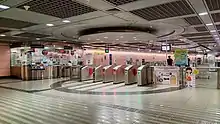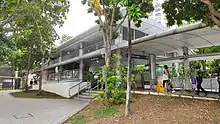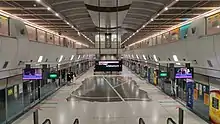Kovan MRT station
Kovan MRT station is an underground Mass Rapid Transit (MRT) station on the North East line (NEL) in Hougang, Singapore. Located underneath Upper Serangoon Road, the station serves the retail development of Heartland Mall and surrounding public and private residences.
NE13
Kovan 高文 கோவன் Kovan | |||||||||||
|---|---|---|---|---|---|---|---|---|---|---|---|
| Mass Rapid Transit (MRT) station | |||||||||||
 Exit C of Kovan MRT station. | |||||||||||
| Location | 900 Upper Serangoon Road Singapore 534799[1] | ||||||||||
| Coordinates | 1°21′37″N 103°53′06″E | ||||||||||
| Operated by | SBS Transit Ltd (ComfortDelGro Corporation) | ||||||||||
| Line(s) | |||||||||||
| Platforms | 2 (1 island platform) | ||||||||||
| Tracks | 2 | ||||||||||
| Connections | Bus, Taxi | ||||||||||
| Construction | |||||||||||
| Structure type | Underground | ||||||||||
| Platform levels | 1 | ||||||||||
| Parking | Yes (Heartland Mall) | ||||||||||
| Disabled access | Yes | ||||||||||
| History | |||||||||||
| Opened | 20 June 2003 | ||||||||||
| Electrified | Yes | ||||||||||
| Passengers | |||||||||||
| November 2020 | 13,935 per day[2] | ||||||||||
| Services | |||||||||||
| |||||||||||
| Location | |||||||||||
 Kovan Kovan station in Singapore | |||||||||||
First announced in March 1996, the station commenced operations on 20 June 2003. The station construction required the multiple diversions of Upper Serangoon Road. Like all stations on the NEL, Kovan station is operated by SBS Transit. The station features an artwork The Trade-off by Eng Tow as part of the network's Art-in-Transit programme.
History

The announcement of Kovan station, along with the other NEL stations, in March 1996 caught the residents around the site by "surprise", as it was assumed there would be only one station in Hougang near the Hougang Central Bus Interchange.[3] All the residents were reported to be "happy" due to the expected benefits of being in close proximity with the NEL.[3][4]
Contract C703 for the design and construction of the two-level Civil Defence underground stations (Kovan and Hougang) was awarded to Samsung Corporation Engineering & Construction Group[5] at a contract sum of S$214.8 million (US$144.67 million) in May 1997.[6] The contract additionally includes the construction of 1.3-kilometre (0.81 mi) twin-bored tunnels and 700 metres (770 yd) of cut-and-cover tunnels.[5]
As the location of the utility pipes at the site was not well documented, the contractor has to manually excavate the site using equipment to discover the pipes. After the pipes were unearthed, mechanised excavation could begin. This was to mitigate any damage to the pipes. To facilitate the station's construction and further development of the site, some residences, businesses and a temple have been bought over.[7]
During the MRT construction, the residents have to put up with some inconveniences. A section of Upper Serangoon Road has to be realigned several times for the excavation works. Nevertheless, as the work was well-coordinated, little impact was made to the traffic as much as possible. Road capacity was "by and large" unaffected as most of the work was carried out underneath a metal decking.[4] To avoid bringing further inconvenience, the Land Transport Authority (LTA) also ensured the carpark along Hougang Street 21 remained accessible. This was to ensure that residents could resume their daily activities without needing to park further away.[8]
The station opened on 20 June 2003 along with the other NEL stations.[9][10] In light of the station's opening, the retail mall (renamed Heartland Mall Kovan) next to the station has been renovated greatly and has leased to important chains such as Cold Storage and Pizza Hut to operate at the mall.[11]
Station details
Location
The station is located in the Kovan neighbourhood, underneath Upper Serangoon Road.[12] The station serves the residential developments of Kovan Melody and Kovan Residences, the retail development of Heartland Mall, and is within walking distances to the Kovan Market and Food Centre and the Paya Lebar Community Club.[13]
Services
The station serves the North East line (NEL) between the Serangoon and Hougang stations. The station code is NE13 as reflected on official maps.[14] The station operates between 5.51 am and 12.21 am daily[15] with headways of 2.5 to 5 minutes depending on peak hours.[16]
Design

Kovan station has three entrances and two underground levels.[17] The entrances have a steel structure with a curved aluminium roof intended to create a "streamlined effect". In addition, to create a spacious interior, there are no pillars in the station.[17][18]
Public artwork

An artwork The Trade-off by Eng Tow is displayed at this station as part of the MRT network's Art-in-Transit (AiT) programme.[lower-alpha 1][19][20][21] Reflecting the time and progress of the Kovan area, two maps are depicted: One of the past and the other of the present. The former includes natural areas such as mangrove swamps, forests, plantations and water bodies around the existing arterial roads of Serangoon Road and Tampines Road, while the latter has the vegetation removed with only the new roads, expressways and new developments.[18][19] Laid on granite (used as it is indigenous to Singapore and familiar to many), the colours of ochre, black, dark green, red and grey were used to reflect earth tones. The tiles were cut using computer-controlled water jets, a novel feature of construction technology in Singapore, and fitted together like a jigsaw puzzle to be displayed on the platforms.[18]
The artist intended for the artwork to reflect the advancements in our way of life as a result of development, transportation and globalisation, by contrasting the styles of the two maps. The older map is mainly "curvilinear and organic" while the modern map is more "geometrical". Eng Tow also kept in mind LTA's aim in the AiT programme - to allow commuters to interact with the artwork.[18] Being located in a station, the work has a tone of irony, as the station was the "embodiment" of a fast-paced lifestyle, with travellers using direct routes to their destinations without stopping.[22]
Before starting on the concept, the artist went through the archives to research on the area's history and discovered interesting details about the area. The artist learnt that the area was in a watershed that began at Paya Lebar and ended at the Singapore River. Additionally, around Serangoon, there were rubber and coconut plantations and orchards indicated by agricultural icons in older maps.[22] To accompany the artwork, Eng Teo initially planned to create wall panels engraved with cartographic symbols. However, this idea was not considered practical due to the mechanical and engineering criteria for the station. Instead, the icons were inscribed in stainless steel and randomly distributed across the floor of the concourse level. Each of the three entrances has a particular symbol which "subtly" aids commuters in identifying the entrances.[22]
The Trade-off has been "widely regarded" as one of the more "sophisticated, thoughtful artwork" on the NEL. A member of the Art Review Panel Joseph McNally remarked that the work has a degree of sophistication not seen in other public works. While "standing on its artistic merit", the work has offered a view of the area and its heritage.[23] The artist remarked that she did not expect commuters to immediately understand the purpose of the work, saying that it might even take "years of travelling" through the station to discover the maps. She hopes the work, when noticed by commuters, will "light up" their commute and urge them to think about the artwork's message.[23]
Notes and references
Footnotes
- Public art showcase which integrates artworks into the MRT network
References
- "Location View of 900 Upper Serangoon Road, 534799". streetdirectory.com. 25 December 2020. Archived from the original on 28 December 2020. Retrieved 25 December 2020.
- "Land Transport DataMall". mytransport.sg. Archived from the original on 21 August 2020. Retrieved 11 December 2020.
- "Residents in N-E corridor happy with station sites". The Straits Times. 6 March 1996. p. 16.
- Leong 2003, p. 164.
- Leong 2003, p. 175.
- "Samsung wins $215 million NE job". Business Times. 25 May 1997. p. 5.
- Leong 2003, p. 169.
- Leong 2003, p. 166.
- "North East Line Opens for Passenger Service!". www.lta.gov.sg. 20 June 2003. Archived from the original on 3 December 2007.
- "It's a smooth ride on NEL – mostly". The Straits Times. 21 June 2003. p. 1.
Minor hitches aside, the North-East Line got off to a smooth start yesterday
- "All set for crowds". The Straits Times. 21 June 2003. p. H16.
- "Kovan MRT station". Google Maps. Archived from the original on 28 December 2020. Retrieved 27 December 2020.
- "Train Service Information". SBSTransit. Archived from the original on 28 December 2020. Retrieved 27 December 2020.
- "MRT System Map" (PDF). www.lta.gov.sg. Archived (PDF) from the original on 21 August 2020. Retrieved 21 December 2020.
- "First Train/ Last Train". SBSTransit. 2 June 2020. Archived from the original on 28 November 2019. Retrieved 27 December 2020.
- "LTA | Transport Tools | MRT/LRT". www.lta.gov.sg. Archived from the original on 1 November 2019. Retrieved 11 May 2020.
- "North East Line: Kovan Station". www.lta.gov.sg. Archived from the original on 3 December 2007. Retrieved 21 December 2020.
- Tan 2003, p. 134.
- "Getting Around | Public Transport | A Better Public Transport Experience | Art in Transit". www.lta.gov.sg. Land Transport Authority. Archived from the original on 21 April 2020. Retrieved 11 July 2020.
- "Art-in-Transit". SBSTransit. 15 December 2020. Archived from the original on 21 April 2020. Retrieved 22 December 2020.
- "Commissions". ENG TOW ARTIST. Archived from the original on 28 December 2020. Retrieved 28 December 2020.
- Tan 2003, p. 135.
- Tan 2003, p. 137.